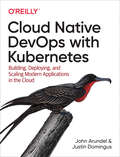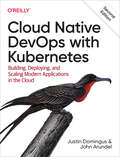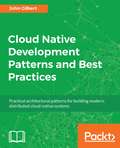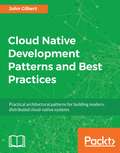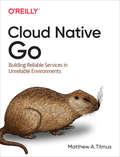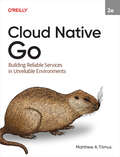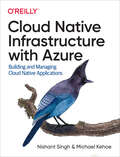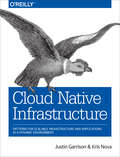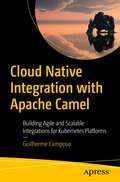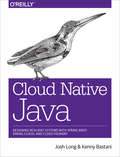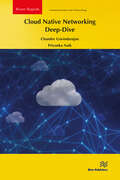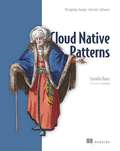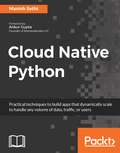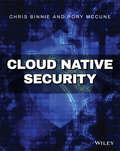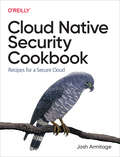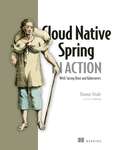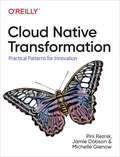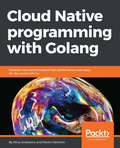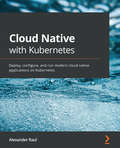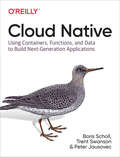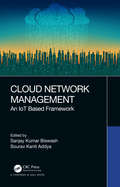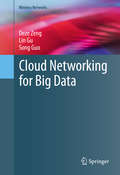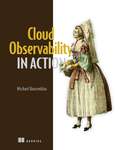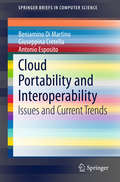- Table View
- List View
Cloud Native DevOps with Kubernetes: Building, Deploying, and Scaling Modern Applications in the Cloud
by John Arundel Justin DomingusKubernetes is the operating system of the cloud-native world, providing a reliable and scalable platform for running containerized workloads. This book shows developers and operations staff how to apply industry-standard DevOps practices to Kubernetes in a cloud-native context. You’ll learn all about the Kubernetes ecosystem and discover battle-tested solutions to everyday problems.In this friendly, pragmatic book, cloud experts John Arundel and Justin Domingus show you what Kubernetes can do—and what you can do with it. You’ll build, step by step, an example cloud-native application and its supporting infrastructure, along with a development environment and continuous deployment pipeline that you can use for your own applications.Understand containers and Kubernetes from first principles—no experience necessaryRun your own clusters or choose a managed Kubernetes service from Amazon, Google, and othersDesign your own cloud-native services and infrastructureUse Kubernetes to manage resource usage and the container lifecycleOptimize clusters for cost, performance, resilience, capacity, and scalabilityLearn the best tools for developing, testing, and deploying your applicationsApply the latest industry practices for observability and monitoringSecure your containers and clusters in productionAdopt DevOps principles to help make your development teams lean, fast, and effective
Cloud Native DevOps with Kubernetes: Building, Deploying, and Scaling Modern Applications in the Cloud
by John Arundel Justin DomingusKubernetes has become the operating system of today's cloud native world, providing a reliable and scalable platform for running containerized workloads. In this friendly, pragmatic book, cloud experts Justin Domingus and John Arundel show you what Kubernetes can do-and what you can do with it. This updated second edition guides you through the growing Kubernetes ecosystem and provides practical solutions to everyday problems with software tools currently in use. You'll walk through an example containerized application running in Kubernetes step-by-step, from the development environment through the continuous deployment pipeline, exploring patterns you can use for your own applications. Make your development teams lean, fast, and effective by adopting Kubernetes and DevOps principles. Understand containers and Kubernetes-no experience necessaryRun your own applications on managed cloud Kubernetes services or on-prem environmentsDesign your own cloud native services and infrastructureUse Kubernetes to manage resource usage and the container lifecycleOptimize clusters for cost, performance, resilience, capacity, and scalabilityLearn the best tools for developing, testing, and deploying your applicationsApply the latest industry practices for observability and monitoringSecure your containers and clusters in production
Cloud Native Development Patterns and Best Practices: Practical Architectural Patterns For Building Modern, Distributed Cloud-native Systems
by John Gilbert<P><P>Learn to apply cloud-native patterns and practices to deliver responsive, resilient, elastic, and message-driven systems with confidence <P><P>Key Features <P><P>Understand the architectural patterns involved in cloud-native architectures <P><P>Minimize risk by evolving your monolithic applications into distributed cloud-native systems <P><P>Discover best practices for applying cloud-native patterns to your enterprise-level cloud applications <P><P>Book Description <P><P>Build systems that leverage the benefits of the cloud and applications faster than ever before with cloud-native development. This book focuses on architectural patterns for building highly scalable cloud-native systems. You will learn how the combination of cloud, reactive principles, devops, and automation enable teams to continuously deliver innovation with confidence. <P><P>Begin by learning the core concepts that make these systems unique. You will explore foundational patterns that turn your database inside out to achieve massive scalability with cloud-native databases. You will also learn how to continuously deliver production code with confidence by shifting deployment and testing all the way to the left and implementing continuous observability in production. There's more-you will also learn how to strangle your monolith and design an evolving cloud-native system. <P><P>By the end of the book, you will have the ability to create modern cloud-native systems. <P><P>What you will learn <P><P>Enable massive scaling by turning your database inside out <P><P>Unleash flexibility via event streaming <P><P>Leverage polyglot persistence and cloud-native databases <P><P>Embrace modern continuous delivery and testing techniques <P><P>Minimize risk by evolving your monoliths to cloud-native <P><P>Apply cloud-native patterns and solve major architectural problems in cloud environment <P><P>Who This Book Is For <P><P>This book is for developers who would like to progress into building cloud-native systems and are keen to learn the patterns involved. Basic knowledge of programming and cloud computing is required.
Cloud Native Development Patterns and Best Practices: Practical architectural patterns for building modern, distributed cloud-native systems
by John GilbertLearn to apply cloud-native patterns and practices to deliver responsive, resilient, elastic, and message-driven systems with confidence Key Features Understand the architectural patterns involved in cloud-native architectures Minimize risk by evolving your monolithic applications into distributed cloud-native systems Discover best practices for applying cloud-native patterns to your enterprise-level cloud applications Book Description Build systems that leverage the benefits of the cloud and applications faster than ever before with cloud-native development. This book focuses on architectural patterns for building highly scalable cloud-native systems. You will learn how the combination of cloud, reactive principles, devops, and automation enable teams to continuously deliver innovation with confidence. Begin by learning the core concepts that make these systems unique. You will explore foundational patterns that turn your database inside out to achieve massive scalability with cloud-native databases. You will also learn how to continuously deliver production code with confidence by shifting deployment and testing all the way to the left and implementing continuous observability in production. There's more—you will also learn how to strangle your monolith and design an evolving cloud-native system. By the end of the book, you will have the ability to create modern cloud-native systems. What you will learn Enable massive scaling by turning your database inside out Unleash flexibility via event streaming Leverage polyglot persistence and cloud-native databases Embrace modern continuous delivery and testing techniques Minimize risk by evolving your monoliths to cloud-native Apply cloud-native patterns and solve major architectural problems in cloud environment Who this book is for This book is for developers who would like to progress into building cloud-native systems and are keen to learn the patterns involved. Basic knowledge of programming and cloud computing is required.
Cloud Native Development with Google Cloud: Building Applications at Speed and Scale
by Daniel VaughanCloud native development gives you the power to rapidly build, secure, and scale software. But you still need to navigate many potential pitfalls along the way. Through practical examples, this book demonstrates how to use Google Cloud as a laboratory to enable rapid innovation, a factory to automate build and testing, and a citadel to operate applications at scale securely.Author Daniel Vaughan shows you how to take applications from prototype to production by combining Google Cloud services, a cloud native programming model, and best practices. By following an example project from start to finish, developers, architects, and engineering managers working with the Google Cloud Platform will learn how to build and run cloud native applications on Google Cloud with confidence.With this book, you will:Understand cloud native development concepts including microservices, containerization, and event-driven architectureLearn Google Cloud services that specifically support this development style: compute, persistence, messaging, DevOps, security and networking, and observabilityConfidently build cloud native applications on Google CloudLearn how to address nonfunctional requirements such as security, observability, and testingSuccessfully make the transition from initial proofs of concept and prototypes to production systems
Cloud Native Go
by Matthew A. TitmusWhat do Docker, Kubernetes, and Prometheus have in common? All of these cloud native technologies are written in the Go programming language. This practical book shows you how to use Go's strengths to develop cloud native services that are scalable and resilient, even in an unpredictable environment. You'll explore the composition and construction of these applications, from lower-level features of Go to mid-level design patterns to high-level architectural considerations.Each chapter builds on the lessons of the last, walking intermediate to advanced developers through Go to construct a simple but fully featured distributed key-value store. You'll learn best practices for adopting Go as your development language for solving cloud native management and deployment issues.Learn how cloud native applications differ from other software architecturesUnderstand how Go can solve the challenges of designing scalable distributed servicesLeverage Go's lower-level features, such as channels and goroutines, to implement a reliable cloud native serviceExplore what "service reliability" is and what it has to do with cloud nativeApply a variety of patterns, abstractions, and tooling to build and manage complex distributed systems
Cloud Native Go: Building Reliable Services in Unreliable Environments
by Matthew A. TitmusLearn how to use Go's strengths to develop services that are scalable and resilient even in an unpredictable environment. With this book's expanded second edition, Go developers will explore the composition and construction of cloud native applications, from lower-level Go features and mid-level patterns to high-level architectural considerations.Each chapter in this new edition builds on the lessons of the previous chapter, taking intermediate to advanced developers through Go to construct a simple but fully featured distributed key-value store. You'll learn about Go generics, dependability and reliability, memory leaks, and message-oriented middleware. New chapters on security and distributed state delve into critical aspects of developing secure distributed cloud native applications.With this book you will:Learn the features that make Go an ideal language for building cloud native softwareUnderstand how Go solves the challenges of designing scalable distributed servicesDesign and implement a reliable cloud native service by leveraging Go's lower-level features such as channels and goroutinesApply patterns, abstractions, and tooling to effectively build and manage complex distributed systemsOvercome stumbling blocks when using Go to build and manage a cloud native service
Cloud Native Infrastructure with Azure: Building and Managing Cloud Native Applications
by Nishant Singh Michael KehoeThe cloud is becoming the de facto home for companies ranging from enterprises to startups. Moving to the cloud means moving your applications from monolith to microservices. But once you do, running and maintaining these services brings its own level of complexity. The answer? Modularity, deployability, observability, and self-healing capacity through cloud native development.With this practical book, Nishant Singh and Michael Kehoe show you how to build a true cloud native infrastructure using Microsoft Azure or another cloud computing solution by following guidelines from the Cloud Native Computing Foundation (CNCF). DevOps and site reliability engineers will learn how adapting applications to cloud native early in the design phase helps you fully utilize the elasticity and distributed nature of the cloud.This book helps you explore:Why go cloud native?How to use infrastructure as codeWhat it takes to containerize an applicationWhy and how Kubernetes is the "grand orchestrator"How to create a Kubernetes cluster on AzureHow observability complements monitoringHow to use service discovery and a service mesh to find new territoriesHow networking and policy management serve as gatekeepersHow distributed databases and storage work
Cloud Native Infrastructure: Patterns for Scalable Infrastructure and Applications in a Dynamic Environment
by Justin Garrison Kris NovaCloud native infrastructure is more than servers, network, and storage in the cloud—it is as much about operational hygiene as it is about elasticity and scalability. In this book, you’ll learn practices, patterns, and requirements for creating infrastructure that meets your needs, capable of managing the full life cycle of cloud native applications.Justin Garrison and Kris Nova reveal hard-earned lessons on architecting infrastructure from companies such as Google, Amazon, and Netflix. They draw inspiration from projects adopted by the Cloud Native Computing Foundation (CNCF), and provide examples of patterns seen in existing tools such as Kubernetes.With this book, you will:Understand why cloud native infrastructure is necessary to effectively run cloud native applicationsUse guidelines to decide when—and if—your business should adopt cloud native practicesLearn patterns for deploying and managing infrastructure and applicationsDesign tests to prove that your infrastructure works as intended, even in a variety of edge casesLearn how to secure infrastructure with policy as code
Cloud Native Integration with Apache Camel: Building Agile and Scalable Integrations for Kubernetes Platforms
by Guilherme CamposoAddress the most common integration challenges, by understanding the ins and outs of the choices and exemplifying the solutions with practical examples on how to create cloud native applications using Apache Camel. Camel will be our main tool, but we will also see some complementary tools and plugins that can make our development and testing easier, such as Quarkus, and tools for more specific use cases, such as Apache Kafka and Keycloak. You will learn to connect with databases, create REST APIs, transform data, connect with message oriented software (MOMs), secure your services, and test using Camel. You will also learn software architecture patterns for integration and how to leverage container platforms, such as Kubernetes. This book is suitable for those who are eager to learn an integration tool that fits the Kubernetes world, and who want to explore the integration challenges that can be solved using containers. What You Will Learn Focus on how to solve integration challengesUnderstand the basics of the Quarkus as it’s the foundation for the applicationAcquire a comprehensive view on Apache CamelDeploy an application in Kubernetes Follow good practices Who This Book Is For Java developers looking to learn Apache Camel; Apache Camel developers looking to learn more about Kubernetes deployments; software architects looking to study integration patterns for Kubernetes based systems; system administrators (operations teams) looking to get a better understand of how technologies are integrated.
Cloud Native Java: Designing Resilient Systems with Spring Boot, Spring Cloud, and Cloud Foundry
by Josh Long Kenny BastaniWhat separates the traditional enterprise from the likes of Amazon, Netflix, and Etsy? Those companies have refined the art of cloud native development to maintain their competitive edge and stay well ahead of the competition. This practical guide shows Java/JVM developers how to build better software, faster, using Spring Boot, Spring Cloud, and Cloud Foundry.Many organizations have already waded into cloud computing, test-driven development, microservices, and continuous integration and delivery. Authors Josh Long and Kenny Bastani fully immerse you in the tools and methodologies that will help you transform your legacy application into one that is genuinely cloud native.In four sections, this book takes you through:The Basics: learn the motivations behind cloud native thinking; configure and test a Spring Boot application; and move your legacy application to the cloudWeb Services: build HTTP and RESTful services with Spring; route requests in your distributed system; and build edge services closer to the dataData Integration: manage your data with Spring Data, and integrate distributed services with Spring’s support for event-driven, messaging-centric architecturesProduction: make your system observable; use service brokers to connect stateful services; and understand the big ideas behind continuous delivery
Cloud Native Networking Deep-Dive (River Publishers Rapids Series in Communications and Networking)
by Priyanka Naik Chander GovindarajanThis book demystifies how Kubernetes networking actually works by walking through a simple but practical simulation that mirrors reality as closely as possible, while skipping the gory details. Widespread adoption of container orchestration platforms like Kubernetes have spawned a whole field of industry products, startups and academic research in the field of container networking, typically termed as cloud-native networking. But, what is cloud-native networking? What are the various pieces and how do they fit together? Over recent years, most applications have been deployed on cloud infrastructure. Kubernetes has been the widely adopted orchestrator for these clouds. Application developers in most cases are unaware of the underlying plumbing in Kubernetes that holds their applications running as containers. Networking is an integral part of any Kubernetes environment and efficiently drives the various abstractions provided by it. Needless to say, it greatly effects the performance of applications, which in general have a humongous amount of inter-microservice communication. The impact is even more profound in multiple cloud environments.
Cloud Native Patterns: Designing change-tolerant software
by Cornelia DavisSummaryCloud Native Patternsis your guide to developing strong applications that thrive in the dynamic, distributed, virtual world of the cloud. This book presents a mental model for cloud-native applications, along with the patterns, practices, and tooling that set them apart.Purchase of the print book includes a free eBook in PDF, Kindle, and ePub formats from Manning Publications.About the TechnologyCloud platforms promise the holy grail: near-zero downtime, infinite scalability, short feedback cycles, fault-tolerance, and cost control. But how do you get there? By applying cloudnative designs, developers can build resilient, easily adaptable, web-scale distributed applications that handle massive user traffic and data loads. Learn these fundamental patterns and practices, and you'll be ready to thrive in the dynamic, distributed, virtual world of the cloud.About the BookWith 25 years of experience under her belt, Cornelia Davis teaches you the practices and patterns that set cloud-native applications apart. With realistic examples and expert advice for working with apps, data, services, routing, and more, she shows you how to design and build software that functions beautifully on modern cloud platforms. As you read, you will start to appreciate that cloud-native computing is more about the how and why rather than the where. What's insideThe lifecycle of cloud-native appsCloud-scale configuration managementZero downtime upgrades, versioned services, and parallel deploysService discovery and dynamic routingManaging interactions between services, including retries and circuit breakersAbout the ReaderRequires basic software design skills and an ability to read Java or a similar language.About the AuthorCornelia Davis is Vice President of Technology at Pivotal Software. A teacher at heart, she's spent the last 25 years making good software and great software developers.Table of ContentsPART 1 - THE CLOUD-NATIVE CONTEXTYou keep using that word: Defining "cloud-native"Running cloud-native applications in productionThe platform for cloud-native softwarePART 2 - CLOUD-NATIVE PATTERNSEvent-driven microservices: It's not just request/responseApp redundancy: Scale-out and statelessnessApplication configuration: Not just environment variablesThe application lifecycle: Accounting for constant changeAccessing apps: Services, routing, and service discoveryInteraction redundancy: Retries and other control loopsFronting services: Circuit breakers and API gatewaysTroubleshooting: Finding the needle in the haystackCloud-native data: Breaking the data monolith
Cloud Native Python
by Manish SethiBuild cloud native applications in Python About This Book • This is the only reliable resource that showcases the tools and techniques you need build robust and resilient cloud native applications in Python • Learn how to architect your application on both, the AWS and Azure clouds for high availability • Assess, monitor, and troubleshoot your applications in the cloud Who This Book Is For This book is ideal for developers with a basic knowledge of Python who want to learn to build, test, and scale their Python-based applications. No prior experience of writing microservices in Python is required. What You Will Learn • Get to know “the way of the cloud”, including why developing good cloud software is fundamentally about mindset and discipline • Know what microservices are and how to design them • Create reactive applications in the cloud with third-party messaging providers • Build massive-scale, user-friendly GUIs with React and Flux • Secure cloud-based web applications: the do's, don'ts, and options • Plan cloud apps that support continuous delivery and deployment In Detail Businesses today are evolving so rapidly that having their own infrastructure to support their expansion is not feasible. As a result, they have been resorting to the elasticity of the cloud to provide a platform to build and deploy their highly scalable applications. This book will be the one stop for you to learn all about building cloud-native architectures in Python. It will begin by introducing you to cloud-native architecture and will help break it down for you. Then you'll learn how to build microservices in Python using REST APIs in an event driven approach and you will build the web layer. Next, you'll learn about Interacting data services and building Web views with React, after which we will take a detailed look at application security and performance. Then, you'll also learn how to Dockerize your services. And finally, you'll learn how to deploy the application on the AWS and Azure platforms. We will end the book by discussing some concepts and techniques around troubleshooting problems that might occur with your applications after you've deployed them. This book will teach you how to craft applications that are built as small standard units, using all the proven best practices and avoiding the usual traps. It's a practical book: we're going to build everything using Python 3 and its amazing tooling ecosystem. The book will take you on a journey, the destination of which, is the creation of a complete Python application based on microservices over the cloud platform Style and approach Filled with examples, this book takes a step-by-step approach to teach you each and every configuration you need to make your application highly available and fault tolerant.
Cloud Native Security
by Chris Binnie Rory McCuneExplore the latest and most comprehensive guide to securing your Cloud Native technology stack Cloud Native Security delivers a detailed study into minimizing the attack surfaces found on today’s Cloud Native infrastructure. Throughout the work hands-on examples walk through mitigating threats and the areas of concern that need to be addressed. The book contains the information that professionals need in order to build a diverse mix of the niche knowledge required to harden Cloud Native estates. The book begins with more accessible content about understanding Linux containers and container runtime protection before moving on to more advanced subject matter like advanced attacks on Kubernetes. You’ll also learn about: Installing and configuring multiple types of DevSecOps tooling in CI/CD pipelines Building a forensic logging system that can provide exceptional levels of detail, suited to busy containerized estates Securing the most popular container orchestrator, Kubernetes Hardening cloud platforms and automating security enforcement in the cloud using sophisticated policies Perfect for DevOps engineers, platform engineers, security professionals and students, Cloud Native Security will earn a place in the libraries of all professionals who wish to improve their understanding of modern security challenges.
Cloud Native Security Cookbook: Recipes for a Secure Cloud
by Josh ArmitageWith the rise of the cloud, every aspect of IT has been shaken to its core. The fundamentals for building systems are changing, and although many of the principles that underpin security still ring true, their implementation has become unrecognizable. This practical book provides recipes for AWS, Azure, and GCP to help you enhance the security of your own cloud native systems.Based on his hard-earned experience working with some of the world's biggest enterprises and rapidly iterating startups, consultant Josh Armitage covers the trade-offs that security professionals, developers, and infrastructure gurus need to make when working with different cloud providers. Each recipe discusses these inherent compromises, as well as where clouds have similarities and where they're fundamentally different.Learn how the cloud provides security superior to what was achievable in an on-premises worldUnderstand the principles and mental models that enable you to make optimal trade-offs as part of your solutionLearn how to implement existing solutions that are robust and secure, and devise design solutions to new and interesting problemsDeal with security challenges and solutions both horizontally and vertically within your business
Cloud Native Spring in Action: With Spring Boot and Kubernetes
by Thomas VitaleBuild and deliver production-grade cloud-native apps with Spring framework and Kubernetes. In Cloud Native Spring in Action you&’ll learn: Cloud native best practices and design patterns Build and test cloud native apps with Spring Boot and Spring Cloud Handle security, resilience, and scalability in imperative and reactive applications Configure, deploy, and observe applications on Kubernetes Continuous delivery and GitOps to streamline your software lifecycle Cloud Native Spring in Action is a practical guide to building applications that are designed for cloud environments. You&’ll learn effective Spring and Kubernetes cloud development techniques that you can immediately apply to enterprise-grade applications. Follow a detailed and complete cloud native system from first concept right through to production and deployment, learning best practices, design patterns, and little-known tips and tricks for pain-free cloud native development. Including coverage of security, continuous delivery, and configuration, this hands-on guide is the perfect primer for navigating the increasingly complex cloud landscape. About the technology Do you want to learn how to build scalable, resilient, and observable Spring applications that take full advantage of the cloud computing model? If so, Cloud Native Spring in Action is the book for you! It will teach you the essential techniques and practices you need to build efficient Spring Boot applications ready for production in the cloud. About the book In Cloud Native Spring in Action, you&’ll learn how to containerize your Spring Boot applications with Cloud Native Buildpacks and deploy them on Kubernetes. This practical guide delivers unique insights into hosting microservices, serverless applications, and other modern architectures on cloud platforms. You&’ll learn how to use Spring-based methodologies, practices, and patterns that you won&’t find anywhere else. What's inside Implement cloud native patterns with Spring Handle security, resilience, and scalability Build and test imperative and reactive applications Configuration and observability on Kubernetes Adopt continuous delivery and GitOps About the reader For intermediate Java developers. About the author Thomas Vitale is a software engineer, open source contributor, and international conference speaker. Table of Contents PART 1 CLOUD NATIVE FUNDAMENTALS 1 Introduction to cloud native 2 Cloud native patterns and technologies PART 2 CLOUD NATIVE DEVELOPMENT 3 Getting started with cloud native development 4 Externalized configuration management 5 Persisting and managing data in the cloud 6 Containerizing Spring Boot 7 Kubernetes fundamentals for Spring Boot PART 3 CLOUD NATIVE DISTRIBUTED SYSTEMS 8 Reactive Spring: Resilience and scalability 9 API gateway and circuit breakers 10 Event-driven applications and functions 11 Security: Authentication and SPA 12 Security: Authorization and auditing
Cloud Native Transformation: Practical Patterns for Innovation
by Pini Reznik Jamie Dobson Michelle GienowIn the past few years, going cloud native has been a big advantage for many companies. But it’s a tough technique to get right, especially for enterprises with critical legacy systems. This practical hands-on guide examines effective architecture, design, and cultural patterns to help you transform your organization into a cloud native enterprise—whether you’re moving from older architectures or creating new systems from scratch.By following Wealth Grid, a fictional company, you’ll understand the challenges, dilemmas, and considerations that accompany a move to the cloud. Technical managers and architects will learn best practices for taking on a successful company-wide transformation.Cloud migration consultants Pini Reznik, Jamie Dobson, and Michelle Gienow draw patterns from the growing community of expert practitioners and enterprises that have successfully built cloud native systems. You’ll learn what works and what doesn’t when adopting cloud native—including how this transition affects not just your technology but also your organizational structure and processes.You’ll learn:What cloud native means and why enterprises are so interested in itCommon barriers and pitfalls that have affected other companies (and how to avoid them)Context-specific patterns for a successful cloud native transformationHow to implement a safe, evolutionary cloud native approachHow companies addressed root causes and misunderstandings that hindered their progressCase studies from real-world companies that have succeeded with cloud native transformations
Cloud Native programming with Golang: Develop microservice-based high performance web apps for the cloud with Go
by Martin Helmich Mina Andrawos Jelmer SnoeckKey Features Build well-designed and secure microservices. Enrich your microservices with continous integration and monitoring. Containerize your application with Docker Deploy your application to AWS. Learn how to utilize the powerful AWS services from within your application Book Description Cloud computing and microservices are two very important concepts in modern software architecture. They represent key skills that ambitious software engineers need to acquire in order to design and build software applications capable of performing and scaling. Go is a modern cross-platform programming language that is very powerful yet simple; it is an excellent choice for microservices and cloud applications. Go is gaining more and more popularity, and becoming a very attractive skill.. The book will take you on a journey into the world of microservices and cloud computing with the help of Go. It will start by covering the software architectural patterns of cloud applications, as well as practical concepts regarding how to scale, distribute, and deploy those applications. You will also learn how to build a JavaScript-based front-end for your application, using TypeScript and React. From there, we dive into commercial cloud offerings by covering AWS. Finally, we conclude our book by providing some overviews of other concepts and technologies that the reader can explore to move from where the book leaves off. What you will learn Understand modern software applications architectures Build secure microservices that can effectively communicate with other services Get to know about event-driven architectures by diving into message queues such as Kafka, Rabbitmq, and AWS SQS. Understand key modern database technologies such as MongoDB, and Amazon’s DynamoDB Leverage the power of containers Explore Amazon cloud services fundamentals Know how to utilize the power of the Go language to access key services in the Amazon cloud such as S3, SQS, DynamoDB and more. Build front-end applications using ReactJS with Go Implement CD for modern applications
Cloud Native with Kubernetes
by Alexander RaulThis book is for developers, architects, DevOps engineers, or anyone interested in developing and managing cloud-native applications. Those already running cloud applications and looking for a better way to manage their platform or others interested in a career change given the recent popularity of Kubernetes will also find this book helpful. Some familiarity with cloud computing, containers and DevOps is required, but no prior knowledge of building production applications using Kubernetes is needed to get started with this book.
Cloud Native: Using Containers, Functions, and Data to Build Next-Generation Applications
by Peter Jausovec Boris Scholl Trent SwansonDevelopers often struggle when first encountering the cloud. Learning about distributed systems, becoming familiar with technologies such as containers and functions, and knowing how to put everything together can be daunting. With this practical guide, you’ll get up to speed on patterns for building cloud native applications and best practices for common tasks such as messaging, eventing, and DevOps.Authors Boris Scholl, Trent Swanson, and Peter Jausovec describe the architectural building blocks for a modern cloud native application. You’ll learn how to use microservices, containers, serverless computing, storage types, portability, and functions. You’ll also explore the fundamentals of cloud native applications, including how to design, develop, and operate them.Explore the technologies you need to design a cloud native applicationDistinguish between containers and functions, and learn when to use themArchitect applications for data-related requirementsLearn DevOps fundamentals and practices for developing, testing, and operating your applicationsUse tips, techniques, and best practices for building and managing cloud native applicationsUnderstand the costs and trade-offs necessary to make an application portable
Cloud Network Management: An IoT Based Framework
by Sanjay Kumar Biswash and Sourav Kanti AddyaData storage, processing, and management at remote location over dynamic networks is the most challenging task in cloud networks. Users’ expectations are very high for data accuracy, reliability, accessibility, and availability in pervasive cloud environment. It was the core motivation for the Cloud Networks Internet of Things (CNIoT). The exponential growth of the networks and data management in CNIoT must be implemented in fast growing service sectors such as logistic and enterprise management. The network based IoT works as a bridge to fill the gap between IT and cloud networks, where data is easily accessible and available. This book provides a framework for the next generation of cloud networks, which is the emerging part of 5G partnership projects. This contributed book has following salient features, A cloud-based next generation networking technologies. Cloud-based IoT and mobility management technology. The proposed book is a reference for research scholars and course supplement for cloud-IoT related subjects such as distributed networks in computer/ electrical engineering. Sanjay Kumar Biswash is working as an Assistant professor in NIIT University, India. He held Research Scientist position, Institute of Cybernetics, National Research Tomsk Polytechnic University, Russia. He was PDF at LNCC, Brazil and SDSU, USA. He was a visiting researcher to the UC, Portugal. Sourav Kanti Addya is working as an Assistant professor in NITK, Surathkal, India. He was a PDF at IIT Kharagpur, India. He was a visiting scholar at SDSU, USA. He obtained national level GATE scholarship. He is a member of IEEE, ACM.
Cloud Networking for Big Data (Wireless Networks)
by Song Guo Deze Zeng Lin GuThis book introduces two basic big data processing paradigms for batch data and streaming data. Representative programming frameworks are also presented, as well as software defined networking (SDN) and network function virtualization (NFV) technologies as key cloud networking technologies. The authors illustrate that SDN and NFV can be applied to benefit the big data processing by proposing a cloud networking framework. Based on the framework, two case studies examine how to improve the cost efficiency of big data processing. Cloud Networking for Big Data targets professionals and researchers working in big data, networks, wireless communications and information technology. Advanced-level students studying computer science and electrical engineering will also find this book valuable as a study guide.
Cloud Observability in Action (In Action)
by Michael HausenblasDon&’t fly blind. Observability gives you actionable insights into your cloud native systems—from pinpointing errors, to increasing developer productivity, to tracking compliance.Observability is the difference between an error message and an error explanation with a recipe how to resolve the error! You know exactly which service is affected, who&’s responsible for its repair, and even how it can be optimized in the future. Cloud Observability in Action teaches you how to set up an observability system that learns from a cloud application&’s signals, logging, and monitoring, all using free and open source tools. In Cloud Observability in Action you will learn how to: Apply observability in cloud native systems Understand observability signals, including their costs and benefits Apply good practices around instrumentation and signal collection Deliver dashboarding, alerting, and SLOs/SLIs at scale Choose the correct signal types for given roles or tasks Pick the right observability tool for any given function Communicate the benefits of observability to management A well-designed observability system provides insight into bugs and performance issues in cloud native applications. They help your development team understand the impact of code changes, measure optimizations, and track user experience. Best of all, observability can even automate your error handling so that machine users apply their own fixes—no more 3AM calls for emergency outages. About the technology Cloud native systems are made up of hundreds of moving parts. When something goes wrong, it&’s not enough to know there is a problem—you need to know where it is, what it is, and how to fix it. This book takes you beyond traditional monitoring, explaining observability systems that turn application telemetry into actionable insights. About the book Cloud Observability in Action gives you the background and techniques you need to successfully introduce observability into cloud-based serverless and Kubernetes environments. In it, you&’ll learn to use open standards and tools like OpenTelemetry, Prometheus, and Grafana to build your own observability system and end reliance on proprietary software. You&’ll discover insights from different telemetry signals, including logs, metrics, traces, and profiles. Plus, the book&’s rigorous cost-benefit analysis ensures you&’re getting a real return on your observability investment. What's inside Observability in and of cloud native systems Dashboarding, alerting, and SLOs/SLIs at scale Signal types for any role or task State-of-the-art open source observability tools About the reader For application developers, platform owners, DevOps, and SREs. About the author Michael Hausenblas is a Product Owner in the AWS open source observability team. Table of Contents 1 End-to-end observability 2 Signal types 3 Sources 4 Agents and instrumentation 5 Backend destinations 6 Frontend destinations 7 Cloud operations 8 Distributed tracing 9 Developer observability 10 Service level objectives 11 Signal correlation
Cloud Portability and Interoperability: Issues and Current Trends (SpringerBriefs in Computer Science)
by Antonio Esposito Beniamino Di Martino Giuseppina CretellaThis book offers readers a quick, comprehensive and up-to-date overview of the most important methodologies, technologies, APIs and standards related to the portability and interoperability of cloud applications and services, illustrated by a number of use cases representing a variety of interoperability and portability scenarios. The lack of portability and interoperability between cloud platforms at different service levels is the main issue affecting cloud-based services today. The brokering, negotiation, management, monitoring and reconfiguration of cloud resources are challenging tasks for developers and users of cloud applications due to the different business models associated with resource consumption, and to the variety of services and features offered by different cloud providers. In chapter 1 the concepts of cloud portability and interoperability are introduced, together with the issues and limitations arising when such features are lacking or ignored. Subsequently, chapter 2 provides an overview of the state-of-the-art methodologies and technologies that are currently used or being explored to enable cloud portability and interoperability. Chapter 3 illustrates the main cross-platform cloud APIs and how they can solve interoperability and portability issues. In turn, chapter 4 presents a set of ready-to-use solutions which, either because of their broad-scale use in cloud computing scenarios or because they utilize established or emerging standards, play a fundamental part in providing interoperable and portable solutions. Lastly, chapter 5 presents an overview of emerging standards for cloud Interoperability and portability. Researchers and developers of cloud-based services will find here a brief survey of the relevant methodologies, APIs and standards, illustrated by case studies and complemented by an extensive reference list for more detailed descriptions of every topic covered.
